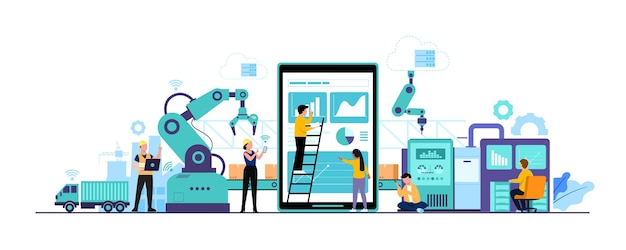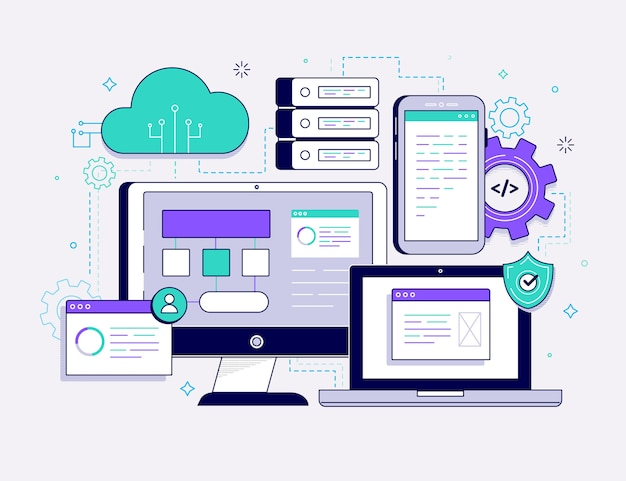System Integration: Types, Methods, and Approaches | Yorkshire Apps
System Integration: Types, Methods, and Approaches
System integration is the process of combining two or more information systems into one comprehensive system. There are many different types of system integration, and each approach has its own benefits and drawbacks. System integration can be used to connect software applications, databases, and devices within an organization, or between different organizations.

Types of system integration
System integration can be classified into different types based on the level of integration, the type of data being exchanged, or the purpose of the integration.
1. Application integration:
The process of connecting two or more software applications so that they can share data and business processes.
Advantages of Application Integration
– Greater efficiency: By sharing data and processes between applications, application integration can help organizations to eliminate duplicative work and improve overall efficiency.
– Improved decision making: Application integration can provide a more holistic view of an organization’s data, which can lead to better decision making.
– Reduced costs: Application integration can help to reduce the costs of IT infrastructure by consolidating multiple systems into one.
Drawbacks of Application Integration
– Complexity: Application integration can be a complex process, and requires careful planning and execution.
– Implementation cost: There can be significant costs associated with implementing an application integration solution.
– Maintenance cost: Once application integration is implemented, there may be ongoing costs associated with maintaining the integration solution.
2. Data Integration
Data integration is the process of combining data from multiple sources into a single view. Data integration can be used to create a centralized data repository, or to merge different data sets for analysis.
Advantages of Data Integration
– Improved data quality: By consolidating data from multiple sources, data integration can help to improve the overall quality of an organization’s data.
– Greater insights: Data integration can provide greater insights into an organization’s business by allowing different data sets to be combined and analyzed.
– Reduced costs: Data integration can help to reduce the costs of storing and managing data by eliminating duplicative data.
Drawbacks of Data Integration
– Complexity: Data integration can be a complex process, and requires careful planning and execution.
– Implementation cost: There can be significant costs associated with implementing a data integration solution.
– Maintenance cost: Once data integration is implemented, there may be ongoing costs associated with maintaining the integration solution.
3. Process Integration:
Process integration is the process of connecting two or more business processes so that they can share data and resources.
Advantages of Process Integration
– Improved efficiency: By automating manual processes and connecting different parts of a business process, process integration can help to improve the overall efficiency of an organization.
– Improved decision making: Process integration can provide a more holistic view of an organization’s data, which can lead to better decision making.
– Reduced costs: Process integration can help to reduce the costs of IT infrastructure by consolidating multiple systems into one.
Drawbacks of Process Integration
– Complexity: Process integration can be a complex process, and requires careful planning and execution.
– Implementation cost: There can be significant costs associated with implementing a process integration solution.
– Maintenance cost: Once process integration is implemented, there may be ongoing costs associated with maintaining the integration solution.
4. Device integration:
The process of connecting devices so that they can share data and resources.
Advantages of Device integration
– Improved efficiency: By connecting devices, device integration can help to improve the overall efficiency of an organization.
– Improved decision making: Device integration can provide a more holistic view of an organization’s data, which can lead to better decision making.
– Reduced costs: Device integration can help to reduce the costs of IT infrastructure by consolidating multiple systems into one.
Drawbacks of Device Integration
– Complexity: Device integration can be a complex process, and requires careful planning and execution.
– Implementation cost: There can be significant costs associated with implementing a device integration solution.
– Maintenance cost: Once device integration is implemented, there may be ongoing costs associated with maintaining the integration solution.
Methods of system integration
There are various methods and approaches for system integration, and the right approach for your organization will depend on your specific needs and requirements. Some common methods of system integration include application programming interface (API) integration, web services, enterprise service bus (ESB), and Extract-Transform-Load (ETL).
– Application programming interface (API) integration: API integration is the process of connecting two or more software applications using an application programming interface (API). The API integration can be used to connect software applications, databases, and devices.
– Web services: Web services are a type of API that allows software applications to communicate with each other over the internet. Web services can be used to connect software applications, databases, and devices.
– Enterprise service bus (ESB): An enterprise service bus (ESB) is a type of middleware that helps to connect software applications, databases, and devices.
– Extract-Transform-Load (ETL): ETL is a process that extracts data from multiple sources, transforms it into a single format, and loads it into a destination database. ETL can be used to connect software applications, databases, and devices.

Approaches to system integration
There are various approaches to system integration, and the right approach for your organization will depend on your specific needs and requirements. Some common approaches to system integration include point-to-point integration, hub-and-spoke integration, messaging integration, web services integration, and service-oriented architecture (SOA).
– Point-to-point integration: Point-to-point integration is a type of system integration that connects two software applications directly.
– Hub-and-spoke integration: Hub-and-spoke integration is a type of system integration that uses a central hub to connect multiple software applications.
– Messaging integration: Messaging integration is a type of system integration that uses messaging middleware to connect software applications.
– Web services integration: Web services integration is a type of system integration that uses web services to connect software applications.
– Service-oriented architecture (SOA): SOA is an approach to system integration that allows software applications to communicate with each other over the internet.

System integration is a process that helps organizations to connect different software applications together in order to share data and automate business processes. There are various methods and approaches for system integration, and the right approach for your organization will depend on your specific needs and requirements. If you are looking to improve the efficiency of your organization, reduce costs, or improve decision-making, system integration may be the right solution for you. Contact us today to learn more about our system integration services.
